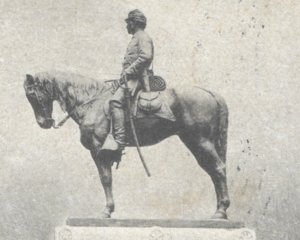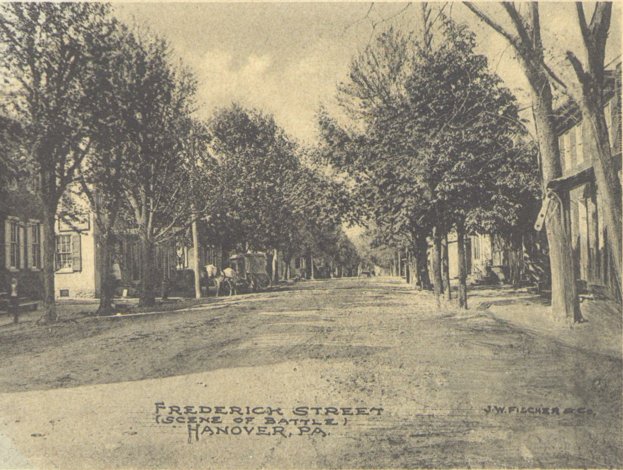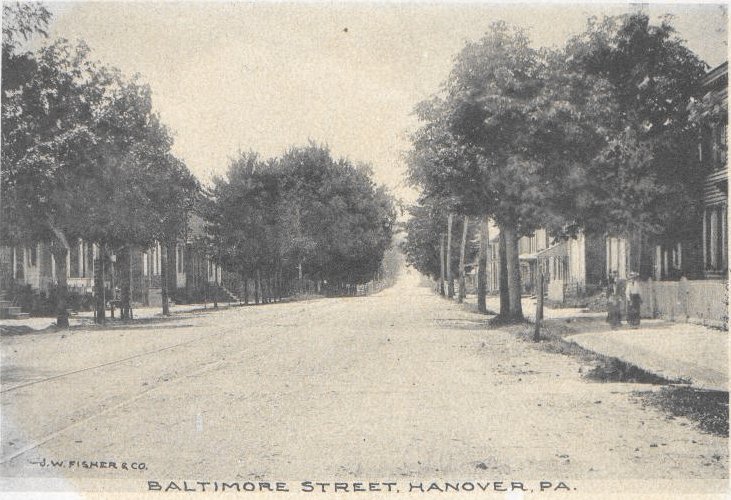

June 30, 1863
Site Author:
Thomas Slaugh
click on pictures for larger version
 Hanover,
Pennsylvania is in the southwestern corner of York County.
It is approximately fifteen miles east of Gettysburg,
Pennsylvania. On June 30, 1863 a cavalry action took place
in the streets and fields in and surrounding Hanover.
Hanover,
Pennsylvania is in the southwestern corner of York County.
It is approximately fifteen miles east of Gettysburg,
Pennsylvania. On June 30, 1863 a cavalry action took place
in the streets and fields in and surrounding Hanover.
The battle began when Confederate General J.E.B. Stuart's cavalry division ran into the rear-guard of Union General Hugh Judson Kilpatrick's division of cavalry. Stuart's first attacking force composed of Colonel Chambliss' brigade.
[Statue of General Kilpatrick, dedicated in 1904, was erected in center square in. It was later moved to the northeast corner of the square where it stands today.]
This rear guard contained around forty men from the 18th Pennsylvania Cavalry. These men were under the command of Captain Potter, also of the 18th Pennsylvania Cavalry. They made a short stand at Gitt's Mill, which is located about three miles southwest of Hanover. They then retreated to the small bridge overlooking Plum Run. The rest of the 18th Pennsylvania Cavalry were there awaiting orders.
 The
18th Pennsylvania also made a short stand then
fled down
Frederick Street. This retreat startled the men of the 5th
New York Cavalry, who were resting in the streets. At this
point, I believe that the Union would have lost the battle
of Hanover if it had not been for the valor of the 5th
New York's commander, Major John Hammond. He kept his
composure and got his command into formation. He called for
an immediate attack. They charged headlong into Colonel
Chambliss' confederate brigade. The hardest fighting during
this charge took place in the field behind where the
Methodist church now stands on Frederick St. By now, the
rest of General Elon Farnsworth’s brigade had come back to
Hanover from their advance of Abbottstown when they heard
the sounds of battle. This cavalry brigade was composed of
the 1st West Virginia and the 1st Vermont, along
with the 18th Pennsylvania and the 5th
New York. At some point during the 5th New York’s
charge, Confederate Lt. Colonel William Payne took Private
Abram Folger from the 5th New York prisoner in
front of the Winebrenner Tannery. While taking him back to
the confederate lines Folger saw a carbine along the road.
He grabbed the carbine and took a shot at Payne. The shot
stunned him more than it did injure him. Payne fell back off
his horse and into the tanning liquid, turning his gray
uniform to a brownish color. He was then taken to
Kilpatrick’s headquarters at the Central Hotel. Also at this
time Private Thomas Burke, of the 5th New York,
captured the flag of one of the attacking confederate
regiments.
The
18th Pennsylvania also made a short stand then
fled down
Frederick Street. This retreat startled the men of the 5th
New York Cavalry, who were resting in the streets. At this
point, I believe that the Union would have lost the battle
of Hanover if it had not been for the valor of the 5th
New York's commander, Major John Hammond. He kept his
composure and got his command into formation. He called for
an immediate attack. They charged headlong into Colonel
Chambliss' confederate brigade. The hardest fighting during
this charge took place in the field behind where the
Methodist church now stands on Frederick St. By now, the
rest of General Elon Farnsworth’s brigade had come back to
Hanover from their advance of Abbottstown when they heard
the sounds of battle. This cavalry brigade was composed of
the 1st West Virginia and the 1st Vermont, along
with the 18th Pennsylvania and the 5th
New York. At some point during the 5th New York’s
charge, Confederate Lt. Colonel William Payne took Private
Abram Folger from the 5th New York prisoner in
front of the Winebrenner Tannery. While taking him back to
the confederate lines Folger saw a carbine along the road.
He grabbed the carbine and took a shot at Payne. The shot
stunned him more than it did injure him. Payne fell back off
his horse and into the tanning liquid, turning his gray
uniform to a brownish color. He was then taken to
Kilpatrick’s headquarters at the Central Hotel. Also at this
time Private Thomas Burke, of the 5th New York,
captured the flag of one of the attacking confederate
regiments.
A lull ensued.
Kilpatrick brought up General Custer’s cavalry brigade and the batteries of Pennington and Elder (12 cannon total). He placed these batteries on Bunker Hill, where the Eichelberger building now stands. Stuart placed his artillery in the cemetery south of town. He also placed some of his artillery on the heights where the South Hanover Golf Course now stands.
During this barrage a round of solid shot hit the Winebrenner home on Frederick Street. The shell penetrated the balcony door and landed in the room where the family was hiding. When it failed to explode, Mr. Winebrenner took the shell and threw it out into the yard.
This barrage lasted for two hours.
By now General George A. Custer had brought up his Michigan cavalry brigade. He deployed the 6th Michigan (already dismounted) from the edge of town to Pennville. They crawled on their hands and knees into the Forney’s field and fired on the enemy who were 300 yards in the distance. The right of the 6th’s line was flanked and fifteen men were captured. They retired immediately.
This action concluded the battle of Hanover. It was a tactical victory for the Union.
That night Stuart retreated to Jefferson. Wade Hampton’s brigade guarded the wagon train that they had captured at Rockville, Maryland. Kilpatrick didn’t waste any time in sending a company to follow Stuart. They followed Stuart all the way to Dover.
 Stuart’s
command eventually found it’s way to Gettysburg. They
arrived on the afternoon of July 2. The next day Lee ordered
Stuart to attack the Union’s right flank. Stuart ran into
Union General David Gregg’s Division of cavalry at the
Rummel Farm, three miles east of Gettysburg. Attached to
Gregg’s command at the time was General Custer and his
cavalry brigade. This skirmish lasted two hours. The contest
ended when Custer attacked and routed Hampton’s cavalry
brigade. Elon Farnsworth was at the other end of the
battlefield, guarding the left flank. After Pickett’s charge
had ended Kilpatrick ordered Farnsworth’s brigade to make a
fruitless charge on Confederate infantry that was hidden in
the woods. Farnsworth refused, but he angrily made the
charge after Kilpatrick questioned his bravery. Farnsworth
was killed in the charge.
Stuart’s
command eventually found it’s way to Gettysburg. They
arrived on the afternoon of July 2. The next day Lee ordered
Stuart to attack the Union’s right flank. Stuart ran into
Union General David Gregg’s Division of cavalry at the
Rummel Farm, three miles east of Gettysburg. Attached to
Gregg’s command at the time was General Custer and his
cavalry brigade. This skirmish lasted two hours. The contest
ended when Custer attacked and routed Hampton’s cavalry
brigade. Elon Farnsworth was at the other end of the
battlefield, guarding the left flank. After Pickett’s charge
had ended Kilpatrick ordered Farnsworth’s brigade to make a
fruitless charge on Confederate infantry that was hidden in
the woods. Farnsworth refused, but he angrily made the
charge after Kilpatrick questioned his bravery. Farnsworth
was killed in the charge.
written by
Thomas L. Slaugh
7th grade student at Hanover Middle School,
300 Keagy Ave., Hanover, Pennsylvania 17331
http://www.hpsd.k12.pa.us
modified last: 1/12/2001
Related Bibliography
Coddington, Edwin B. The Gettysburg Campaign: A Study in Command. New York: Charles Scribner's Sons, 1968.
Encounter at Hanover, Prelude to Gettysburg. The Historical Publication Committee of the Hanover Chamber of Commerce. Gettysburg, PA: Times and News Publishing Company, 1962.
Official Program of t the Centennial of Incorporation of the Borough of Hanover Pennsylvania. Hanover, PA: The Hanover Centennial Committee, 1915.